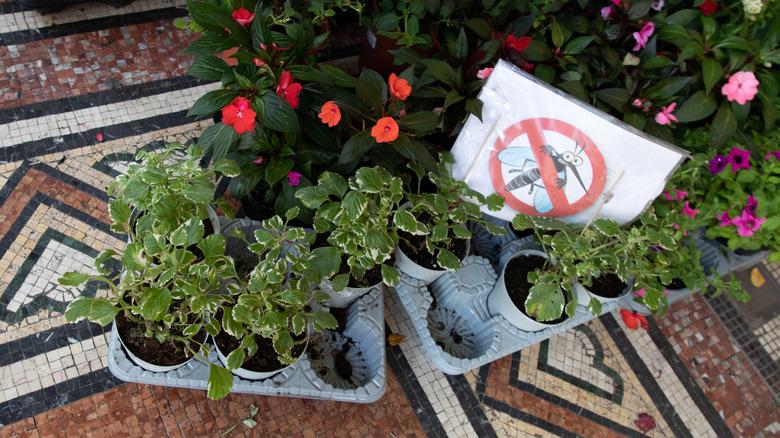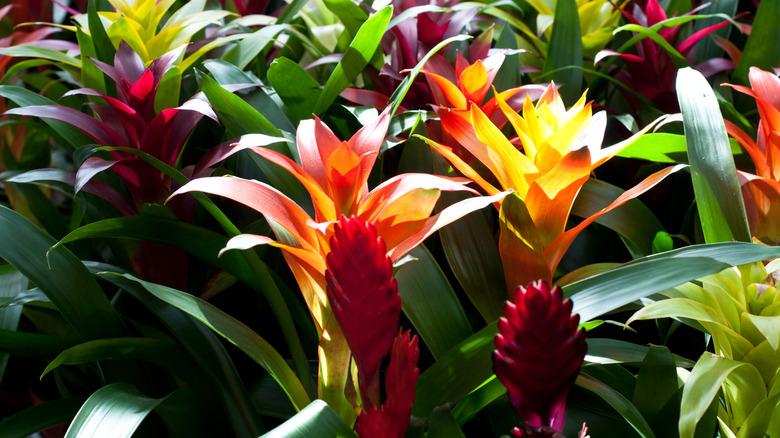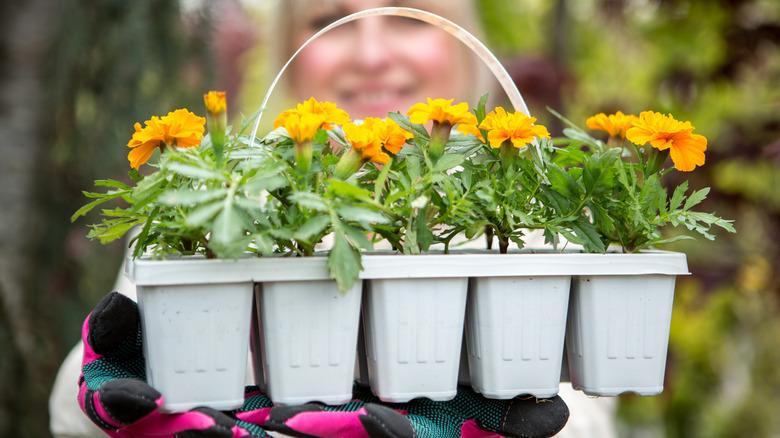If You Want To Keep Mosquitoes Out Of Your Yard, Don't Grow This Plant
For many avid gardeners, a yard full of brightly colored, beautiful blossoms brings absolute joy. And while many blooms attract beneficial visitors, like pollinators (these six plants help pollinators do their jobs, in particular), there are some plants that bring unwanted pests to the yard. Even though they may be beautiful to look at, having them in the garden may be detrimental to your health.
Sadly, bromeliads (Bromeliaceae) are not among the plants that attract beneficial insects to your garden, rather, they attract some of the worst kinds of critters: mosquitoes. Bromeliads, known for their glossy, vibrantly colored rosettes of overlapping leaves and waxy, swooping green blades at the base of the plant, are popular in tropical to sub-tropical regions as ornamental garden additions. Hardy in USDA Zones 10 to 11, these plants thrive in warm weather. However, a unique structural feature of this pineapple-adjacent ornament makes it a beacon for mosquitoes. These plants have water-holding "tanks" within the spiral rosette, much like a funnel or cup, that retains moisture and debris. It creates the perfect conditions for mosquitoes to lay eggs and can be an optimal spawning ground, something you definitely don't want for your garden.
Why science says to think twice about bromeliads
Bromeliads are closely related to pineapples, and their structure resembles the crown of the fruit. In fact, some varieties of the plant do in fact produce fruit, like pineapples, but the ones you likely see in gardens are purely ornamental. Thus, the trumpeted rosettes are left empty for water and other bits to settle in. These small bodies of water, called phytotelm, can also occur in bromeliad's curved leaves at the base of the rosette, making for multiple opportunities for mosquito spawning in just one plant.
And while fostering mosquito life in itself isn't necessarily a bad thing — they do serve positive environmental purposes like feeding birds, bats, and reptiles, after all — researchers warn having bromeliads in your yards may trigger a much bigger health issue. In recent decades, worries from the scientific community include the spreading of disease via mosquitoes. In 2008, bromeliads were removed from Rio de Janeiro following a large-scale dengue outbreak, while in 2016, the plants were also removed from the Miami area during a Zika scare. Other mosquito-borne diseases include: Yellow fever, West Nile virus, and malaria.
If you love the look of bromeliads, consider having them as an indoor, potted plant only, far away from insect larvae that can be harbored in it. Or, if you do want them in your garden, be sure to flush the plants daily to remove any larvae or debris. Consider adding cooking oil to the bromeliad's tank to asphyxiate any existing larvae as well. You can, of course, use larvae insecticides as a deterrent for extra assurance.
Mosquito-repelling alternatives for your garden
The good news is that you don't have to compromise the vibrant colors of your bromeliad to avoid mosquito-mania since there are several insect-repelling plants out there that are equally colorful. Take marigolds (Tagetes) for example; these blossoms come in a range of vibrant hues from lively yellows to scarlet reds, and best of all their scent (more specifically the volatile compounds found in the chemicals that produce that scent) ward of mosquitoes from the yard. Grown as annuals in USDA Zones 2 through 11, these blossoms are both pleasing to the eye and serve a great purpose in the garden.
Sage (Salvia officinalis) is another plant that helps keep pests out of the garden, particularly mosquitoes. Their scent equally repulses mosquitoes and their purple flowers in the summer time adds a vibrant spray of color to the herb garden. Some folks even rub sage on themselves and their pets to temporarily ward off insects. Hardy in Zones 4 to 8 (and possibly 9-12, though it will need some respite from heat), sage is a versatile plant that works wonders both in and out of the garden.
Lastly, for a mosquito-repelling alterative that packs the same vibrant tropical punch as bromeliads, consider Nasturtium (Tropaeolum majus), a trumpeted blossom grown as an annual in Zones 2 to 10. Nasturtiums can grow up to 10 feet tall in height, and their brightly colored blooms and quaint pad-like leaves lends a tropical-leaning touch to some gardens. The scent of the flowers repels mosquitoes, along with a number of other insects like beetles and aphids. As an added bonus, nasturtium flowers are actually edible for humans too!


